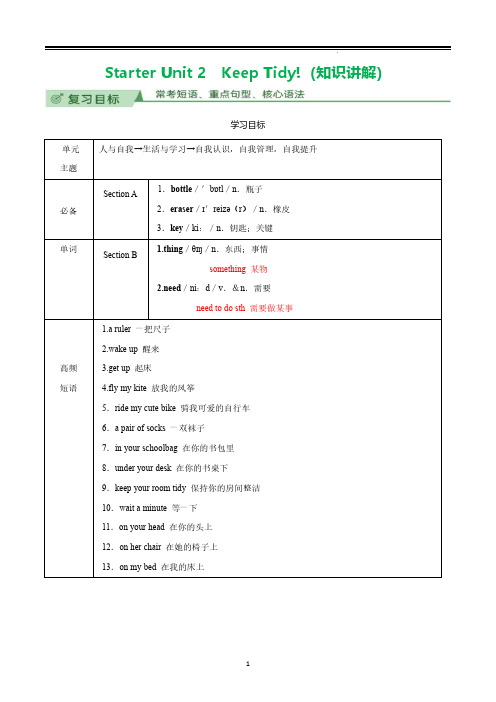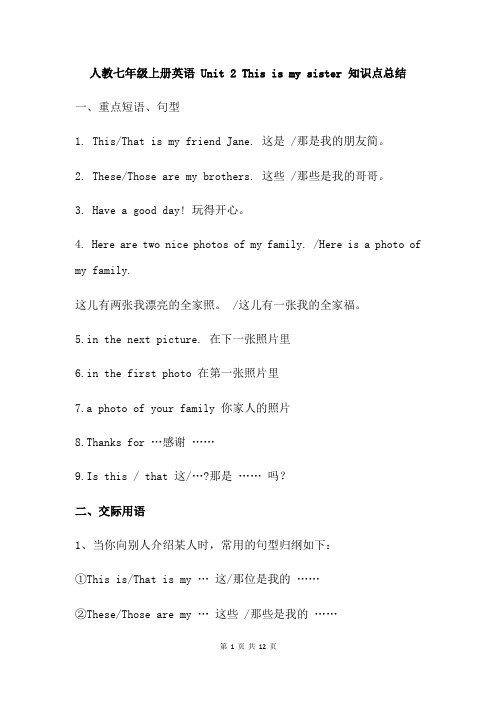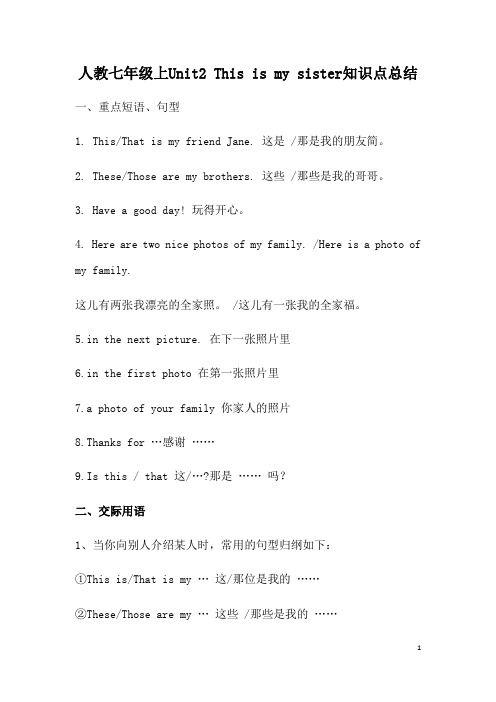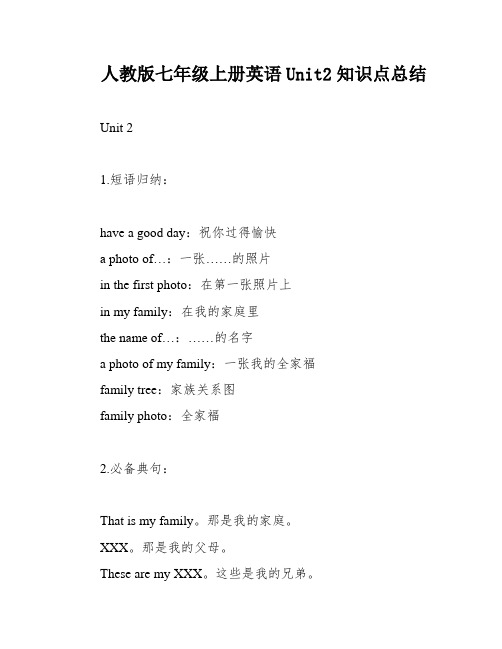七年级上册英语Unit2知识点归纳总结
七年级上册英语Unit2知识点归纳总结

七年级上册英语U n i t2知识点归纳总结-CAL-FENGHAI.-(YICAI)-Company One1七年级英语上册Unit2知识点归纳总结Unit2 Topic1 I have a small nose.一、重点词汇1.反义词:small - big / large long - short black - white tall - short new – old2.my/your/his/her favorite film star 我的/你的/他的/她的最喜爱的电影明星e from =be from 来自、出生于4.look different 长得不像5.in the same grade/school 在同一个年级/学校 in different grades/schools 在不同年级/学校6.have / has 有;吃;喝You have big eyes. She has small eyes. 你有一双大眼睛。
她有一双小眼睛。
7.long 长的 long hair 长头发 8.short 短的 short hair 短头发9. big 大的 big nose 大鼻子 10. small 小的 small nose 小鼻子11. round 圆的 round face 圆圆的脸 12. wide 宽的 wide face 宽宽的脸13. we 我们 We have small mouths. 我们都有小嘴巴。
二、重点句型1.I have a big nose = My nose is big.I have big eyes. = My eyes are big.She has a big nose. = Her nose is big.She has big eyes. = Her eyes are big.2. Who’s that boy那个男孩是谁这是由Who引导的特殊疑问句,询问某人的身份。
人教版初中英语新教材七年级上starterUnit2知识点归纳总结(复习必背)

Starter Unit2KeepTidy!(知识讲解)常考句型1.询问拥有的物品:-What do you have in your schoolbag ?你的书包里有什么?-I have a cap.我有一顶帽子。
2.What colour is /are ...?询问颜色:-What colour is the cap ?这顶帽子是什么颜色的?-It 's...它是······-What colour are the rulers ?这些尺子是什么颜色的?-They 're...它们是······3.Is it on /in /under ...?确定物品的位置:-Is it in your schoolbag ?它在你的书包里吗?-No ,it isn 't.不,它不在。
4.回答感谢:-Oh ,thank you ,Emma !哦,谢谢你,埃玛!-You 're welcome.别客气。
语音知识元音字母a 、e 、i 、o 、u 的发音(1)Section A What do you have ?1.What do you have in your schoolbag ?你的书包里有什么?(教材第7页1a )What do you have in...?······里有什么?本句是what 引导的特殊疑问句,用来询问某人有什么物品。
回答时通常用"I have+a/an+物品名称."。
-What do you have in your pencil box?你的铅笔盒里有什么?-I have a pen.我有一支钢笔。
2.I have a bottle .我有一个瓶子。
(教材第7页1a )(1)a /an [不定冠词]一(个)不定冠词用在单数可数名词或字母前,表示“一”。
人教版七年级上册英语Unit2知识点总结

Unit 21.短语归纳:have a good day 过得愉快 a photo of …………的照片in the first photo 在第一张照片上in my family 在我的家庭里the name of ……的名字 a photo of my family 一张我的全家福family tree 全家福(家族关系图)family photo 全家福2.必备典句:1.That is my family. 那是我的家庭。
2.Those are my parents. 那是我的父母。
3.These are my brothers. 这些是我的兄弟。
4.—Who’s she? 她是谁?—She’s my sister. 她是我的姐姐(妹妹)。
5.This is my sister Kate. 这是我的妹妹凯特。
6.—Nice to meet you , Jane. 见到你很高兴。
—Nice to meet you, too. 见到你我也很高兴。
7.—Are those your parents? 那是你的父母吗?—Yes, they are. 是的,他们是。
8.Well, have a good day! 好吧,祝你们过得愉快!9.Hi, I’m Jenny. 嗨,我是珍妮。
10.Hi, my name is Paul. 嗨,我叫保罗。
11.Here is a photo of my family. 这里有一张我的全家福。
3.指示代词this, that, these, those1.指示代词是表示“这个,那个,这些,那些”的代词,其中this和these是指距离说话人较近的人或者事物;that和those是指离或华人较远的人或者事物。
2.指示代词this, that作主语时,连系动词be用单数形式is,同时后面的名词用单数形式。
当these, those作主语时,连系动词be用复数形式are,同时后面的名词用复数形式。
人教版英语七年级上册 第二单元知识点

Unit 2 This is my sister一.重点词汇1.parent父(母)亲= father or mother, 经常用复数形式”parents”= mother and father.As a parent, you should be kind to your kids.My parents go to work by car.2.family n. 家,家庭(1)family当作整体用时,是单数,谓语动词用单数。
I have a big family.(2)family 强调家庭成员时,是复数含义,谓语动词用复数形式。
My family are watching TV now.(3)family 复数形式是families, 表示”几个家庭”These families are very happy. 这些家庭都很幸福。
3.well(1)作感叹词,可以表示不同的含义Well, I’ve never heard such a story!啊,我从没听过这样一个故事!(表示惊讶)Well, maybe you are right.好吧,或许你是对的。
(表示认可某种事情)(2)作形容词,表示“健康的”I’m well, thank you! 我很好,谢谢你!(3)作副词,意为“好地,令人满意地”He plays tennis very well. 他网球打得非常好。
4.Have a good time!=Have a good day!(祝福语)玩的开心,过得愉快。
对have a good time 的回答通常为:You, too./Thank you, you too!5.photo照片复数:photos短语:a photo of...意为“一张...的照片”Here is a photo of my family.拓展:a photo of.../photos of...是名词所有格形式,相当于one’s photo(s)。
七年级上册英语Unit 2知识点梳理

七年级上册英语Unit 2知识点梳理七年级上册英语Unit 2知识点梳理Unit 2 Is this your pencil ?一、 be 有三个形式:am is are 。
am 是be单第一人称单数形式; is 是be 的第三人称单数形式;are 是be的复数形式; be 是am is are 的原型。
be 的形式与主语的连用:am--------------- I (第一人称单数主语)heshe itthis tha单数名词is----------------- 不可数名词 (第三人称单数主语)动词不定式动名词we you theyare -------------- these those (复数主语)复数名词二、 Excuse me . 可以灵活翻译成“劳驾、打扰了”。
当要“与陌生人搭话”或者“将要做的事会打扰别人”时,使用该语言。
三、含be的肯定句变否定句和一般疑问句的方法以及一般疑问句的回答方法。
含be的肯定句变否定句be + not (is not isnt are not arent )变一般疑问句be提到主语前(am are I you my your)一般疑问句的简略回答用Yes或No回答。
借用一般疑问句的第一个词,且主语用主格人称代词。
练习题 (一)、把下列含be的肯定句先变成否定句,再变成一般疑问句,然后做一般疑问句。
肯定句否定句一般疑问句肯定回答否定回答1、肯定句 This is my pencil . (这是我的铅笔)否定句 This ______my pencil . (这不是我的铅笔)一般疑问句 ______ this______ pencil ? (这是你的铅笔吗)肯定回答 ____________. 否定回答. _____________2、肯定句 That is my eraser .(那是我的橡皮擦)否定句 That ______eraser . (那不是我的橡皮擦)一般疑问句 ______ that ______eraser ? (那是你的橡皮擦)肯定回答 ____________ 否定回答 ______________3、肯定句 These are my pens . (这些是我的钢笔)否定句 These______ my pens . (这些不是我的钢笔)一般疑问句 ______ these ______pens ? (这些是你的钢笔吗)肯定回答 ____________. 否定回答 ____________ .4、肯定句 Those are his baseballs . (那些是他的棒球)否定句 Those ______his baseballs . (那些不是他的棒球)一般疑问句 ______those ______ pens ? (那些是他的棒球吗)肯定回答 ____________ 否定回答 ____________5 、肯定句 I am Helen (我是海伦)否定句 ______ ______Helen . (我不是海伦)一般疑问句 ______ ______Helen . (你是海伦吗)肯定回答 ____________. 否定回答 ____________ .6 、肯定句 It is her notebook . (它是她的笔记本)否定句 It ______her notebook . (它不是她的笔记本)一般疑问句 ______ ______ her notebook ? (它是她的笔记本吗)肯定回答 ____________. 否定回答 ____________ .7、肯定句 A lot of keys are in the pencil—case .(许多钥匙在铅笔合里)否定句 A lot of keys ______in the pencil—case .(许多钥匙不在铅笔盒里)一般疑问句 ______a lot of keys in the pencil—case ? (许多钥匙在铅笔盒里吗?)肯定回答 ____________. 否定回答 ____________ .(二)、补全对话Jim: ______ ______ , Tom . Is this your dictionary ?Tom: Yes,______ ______Jim : Whats this ?Tom: Its _______ eraser .Jim : How do you ______ it ?Tom : E—R—A—S—E—R本快词汇:they他们 these这些 those 那些pencil 铅笔 isnt 不是 arent不是dictionary 词典 baseball棒球 noteball笔记本key钥匙ring 打电话 call 打电话ruler尺子 pen钢笔 pencil—case铅笔盒eraser橡皮擦 a lot of许多every day每天 Excuse me 劳驾打扰了。
人教七年级上册英语 Unit 2 This is my sister 知识点总结

人教七年级上册英语 Unit 2 This is my sister 知识点总结一、重点短语、句型1. This/That is my friend Jane. 这是 /那是我的朋友简。
2. These/Those are my brothers. 这些 /那些是我的哥哥。
3. Have a good day! 玩得开心。
4. Here are two nice photos of my family. /Here is a photo of my family.这儿有两张我漂亮的全家照。
/这儿有一张我的全家福。
5.in the next picture. 在下一张照片里6.in the first photo 在第一张照片里7.a photo of your family 你家人的照片8.Thanks for …感谢……9.Is this / that 这/…?那是……吗?二、交际用语1、当你向别人介绍某人时,常用的句型归纲如下:①This is/That is my …这/那位是我的……②These/Those are my …这些 /那些是我的……③He/She is my …他/她是我的……④They are my …他们是我的……⑤This/That is her/his …这/那是她的 /他的……⑥These/Those are her/his …这些 /那些是她的 /他的……⑦He/She is his/her …他/她是他的 /她的……⑧They are her/his …他们是她的 /他的……2.当你想辨别某人是谁时,常用句型归纳如下:①Is this/that your …?这/那位是你的……吗?②Are these/those your…?…这些 /那些是你的……吗?③Is he/she your …?他/她是你的……吗?④Are they your …?他们是你的……吗?⑤Is this/that her/his…?这/那位是她的 /他的……吗?⑥Are these/those her/his …?这些 /那些是她的 /他的……吗?⑦Is he/she his/her …?他/她是他的 /她的……吗?⑧Are they her/his …?他们是她的 /他的……吗?三、语法1、指示代词 this ,these; those that 的用法。
七年级上册unit2的知识点总结

七年级上册unit2的知识点总结:七年级英语上册的第二单元是一个非常重要的单元,它是学习英语的基础。
本篇文章将会对该单元的知识点进行详细的总结,让你更好地掌握该单元的内容。
一、语法知识点1. 名词复数形式名词的复数形式是非常重要的语法知识点。
在这个单元中,我们需要学习如何将单数名词变为复数。
当单数名词以辅音字母+y结尾时,需要将y改为i加上es来表示复数;当单数名词以s、x、sh、ch结尾时,只需要在单数词尾加上-es就可以了,其他情况都可以在单数名词后面加上-s来表示复数。
2. 表示所属关系的‘of’在英语中,表示所属关系的词语是‘of’,即‘的’,我们需要掌握如何使用‘of’表示所属关系,比如说:“the sister of my mother”,翻成汉语就是“我的妈妈的姐姐”。
3. 一般现在时的三单形式一般现在时的三单形式指的是第三人称单数动词形式,即在动词后面加上‘s’或‘es’。
我们需要掌握不规则动词的变化规则,诸如第三人称动词的变化规则等。
4. 一般现在时的肯定句、否定句和疑问句了解一般现在时的肯定句、否定句和疑问句的构成是非常重要的。
在肯定句中,我们需要根据人称的不同给动词加上不同的词缀;在否定句和疑问句中,我们需要掌握正确的句子结构和使用语序。
二、词汇知识点1. 词根、词缀和单词的拼写规则了解词根、词缀和单词的拼写规则可以帮助我们更好地记住单词。
在本单元中,我们需要掌握很多句型和词组,比如“have to”,“clean up”,“wash the dishes”等。
2. 家庭成员的词汇在词汇方面,我们需要掌握各种家庭成员的称呼,例如:father, mother, brother, sister等。
3. 学校设施和职业的词汇在学习英语中,我们还需要掌握学校设施和职业的相关词汇,例如:teachers, classrooms, library, garden, bus driver, doctor等。
七年级上册英语unit2知识点归纳

七年级上册英语unit2知识点归纳本文将为大家归纳整理七年级上册英语Unit 2的知识点,旨在帮助学生更好地掌握这一单元所学内容。
一、重点词汇1. wake up:醒来例如:I usually wake up at six o'clock in the morning.2. get up:起床例如:I get up after I wake up.3. have breakfast/lunch/dinner:吃早/午/晚饭例如:I usually have breakfast at seven o'clock in the morning.4. go to school:去上学例如:I usually go to school by bus.5. do homework:做作业例如:I always do my homework after school.6. watch TV:看电视例如:I like to watch TV in the evening.二、动词时态1. 一般现在时例如:I usually wake up at six o'clock in the morning.2. 现在进行时例如:I am doing my homework now.3. 一般过去时例如:I went to the park yesterday.4. 过去进行时例如:I was watching TV when my friend called me.三、日常生活用语1. 问候例如:How are you?2. 对话例如:A:What time do you usually wake up?B:I usually wake up at six o'clock in the morning.3. 请求例如:Can you help me with my homework?4. 命令例如:Clean your room, please.四、其他重要知识点1. 序数词例如:first,second,third,fourth,fifth,sixth,seventh,eighth,ninth,tenth2. 人称代词例如:I,you,he,she,it,we,they总之,七年级上册英语Unit 2的知识点主要包括了一些基础的英语词汇、动词时态和常用口语表达等方面,希望大家通过本文的学习,能够更加熟练地运用这些知识点,从而提高自己的英语水平。
七年级英语上册unit2知识点

七年级英语上册unit2知识点第一个知识点:动词的一般现在时态动词的一般现在时态用于表示现在经常重复或者普遍真理的状态或者行为。
它的构成方式是在动词原形的基础上加“s/es”或者不变形,具体规则根据动词的结尾而定。
例如:I always go to school by bus.He usually eats breakfast at 7am.They like playing soccer.第二个知识点:人称代词和物主代词人称代词用来代替特定的人或者物,分为主格和宾格两种形式。
主格通常在句子中做主语,宾格通常在句子中做宾语。
物主代词则表示所属关系,分为形容词性和名词性两种形式。
形容词性物主代词通常放在名词前面作定语,名词性物主代词则直接替代名词。
例如:She is my friend. (人称代词)I lost my book. (形容词性物主代词)This is hers. (名词性物主代词)第三个知识点:一些常见的时间单位在英语中,一些常见的时间单位有:second(秒),minute(分),hour(时),day(天),week (周),month(月),year(年)它们可以用来描述一段时间的长度或者某个具体的时间点。
例如:It took me five minutes to finish the task.I will have a week's vacation next month.My birthday is on October 13th.第四个知识点:形容词的比较级和最高级形容词的比较级和最高级用于表示两个或者多个事物在某个方面的程度高低或者优劣。
比较级的构成方式是在形容词原形后加“er”,最高级则在形容词原形后加“est”。
如果形容词以“e”结尾,只需要加“r/est”即可。
如果形容词以辅音字母+y结尾,只需要将“y”变成“i”,再加“er/est”。
如果形容词以一个元音字母和一个辅音字母结尾,则要在最后一个辅音字母前加“er/est”。
初一英语上册二单元重点归纳笔记

初一英语上册二单元重点归纳笔记一、词汇与短语1. 介词短语:on the weekend:在周末go to the zoo:去动物园have a pic:野餐fly a kite:放风筝2. 连词:and:和but:但是so:所以3. 形容词:interesting:有趣的boring:无聊的exciting:令人兴奋的noisy:吵闹的4. 动词短语:have a good time:过得愉快 watch TV:看电视play basketball:打篮球二、语法知识1. 现在进行时:She is watching TV.:她正在看电视。
They are playing basketball.:他们正在打篮球。
2. 特殊疑问句:What are you doing?:你在做什么?Where is she going?:她要去哪里?3. 形容词和副词的比较级:more interesting:更有趣的less boring:不那么无聊的noisier:更吵闹的4. 情态动词can和can’t:I can fly a kite.:我会放风筝。
He can’t swim.:他不会游泳。
三、句型和交际用语1. 表示喜欢或不喜欢的句型:I like playing the piano.:我喜欢弹钢琴。
She doesn’t like climbing mount本人ns.:她不喜欢爬山。
2. 表示充分或不充分的句型:She has enough time to finish her homework.:她有足够的时间完成作业。
They don’t have much money to buy a new car.:他们没有足够的钱买新车。
3. 表示买东西或选东西的句型:How much is the kite?:这个风筝多少钱?I want to buy a new dress.:我想买一件新连衣裙。
四、阅读与写作1. 阅读理解:阅读理解部分主要考察学生对文章的理解能力,要注意细节把握和推理能力的培养。
人教版七年级上Unit2 This is my sister知识点总结

人教七年级上Unit2 This is my sister知识点总结一、重点短语、句型1. This/That is my friend Jane. 这是 /那是我的朋友简。
2. These/Those are my brothers. 这些 /那些是我的哥哥。
3. Have a good day! 玩得开心。
4. Here are two nice photos of my family. /Here is a photo of my family.这儿有两张我漂亮的全家照。
/这儿有一张我的全家福。
5.in the next picture. 在下一张照片里6.in the first photo 在第一张照片里7.a photo of your family 你家人的照片8.Thanks for …感谢……9.Is this / that 这/…?那是……吗?二、交际用语1、当你向别人介绍某人时,常用的句型归纲如下:①This is/That is my …这/那位是我的……②These/Those are my …这些 /那些是我的……③He/She is my …他/她是我的……④They are my …他们是我的……⑤This/That is her/his …这/那是她的 /他的……⑥These/Those are her/his …这些 /那些是她的 /他的……⑦He/She is his/her …他/她是他的 /她的……⑧They are her/his …他们是她的 /他的……2.当你想辨别某人是谁时,常用句型归纳如下:①Is this/that your …?这/那位是你的……吗?②Are these/those your…?…这些 /那些是你的……吗?③Is he/she your …?他/她是你的……吗?④Are they your …?他们是你的……吗?⑤Is this/that her/his…?这/那位是她的 /他的……吗?⑥Are these/those her/his …?这些 /那些是她的 /他的……吗?⑦Is he/she his/her …?他/她是他的 /她的……吗?⑧Are they her/his …?他们是她的 /他的……吗?三、语法1、指示代词 this ,these; those that 的用法。
人教版初中英语新教材七年级上Unit2知识点归纳总结(复习必背)

Unit 2 We’re family !学习目标单元主题人与社会→社会服务与人际沟通→和谐家庭必备单词Section A1.mean/mi:n/v.意思是;打算2.husband/'hʌzbənd/n.丈夫3.bat/bæt/n.球棒;球拍4.together/tə'geðə(r)/adv.在一起;共同5.spend/spend/v.花(时间、钱等)6.really/'ri:əli/adv.非常;确实;真正地7.member/'membə(r)/n.成员;会员8.activity/æk'tɪvəti/n.活动9.chess/tʃes/n.国际象棋10.funny/'fʌni/adj.好笑的;奇怪的→fun(n.乐趣)11.laugh/la:f/v.笑;发笑n.笑声12.different/'dɪfrənt/adj.不同的→difference(n.差别;不同)13.violin/,vaɪə'lɪn/n.小提琴Section B1.hat/hæt/n.帽子2.handsome/'hænsəm/adj.英俊的3.knee/ni:/n.膝;膝盖4. grandchild /'græntfaɪld/ n.(pl.grandchildren /'græn,tʃɪldrən/) (外)孙子;(外)孙女5.son/sʌn/n.儿子6.hike/haɪk/v.&n.远足;徒步旅行高频短语e in 进来2.ping-pong bat乒乓球拍3.play ping-pong打乒乓球4.every day每天5.fishing rod钓竿6.a lot of/lots of大量;许多7.Chinese chess中国象棋8.play the erhu 拉二胡9.big and clean classroom 又大又干净的教室10.have fun 玩得11.on the left/right 在左边/右边12.at night在夜晚13.in the middle 中间,中部14.go hiking远足15.family photo 家庭照片16.every week 每周17.next to紧邻;在……近旁18.family tree 家谱常考句型1.询问家庭成员:(1)-Is this/Are these your...?这是/这些是你的······吗?-Yes,.../No,...是的,······/不,······(2)-Who's/Who're...?······是谁?-He's/She's/They're...他是/她是/他(她)们是·······2.询问日常发生的事:-Do you often play ping-pong together?你们经常一起打乒乓球吗?-Yes,we play every day/week.是的,我们每天/每周都打。
七年级上册英语Starter Unit2知识点总结

Starter unit 21.短语归纳:in English 用英语an orange 一个橙子spell it 拼写它 a ruler 一把尺子2.必背典句—What’s this in English? 这个用英语怎么说?—It’s an orange. 它是一个橙子。
—Spell it, please. 请拼写它。
—O-R-A-N-G-E3.不定冠词a / an 的用法不定冠词a / an表示微弱的“一”的概念,但并不强调数目,只表示名词为不特定者。
A 用在以辅音音素开头的单词或者字母前,an用在以元音因素开头的单词或者字母前①表示数量“一”。
a book 一本书an egg 一个鸡蛋②笼统地指某人或者某物,但不具体说明。
There is a car in the yard. 院子里有一辆小汽车。
③泛指某一类人或事物。
A house is a useful animal 马是有用的动物。
④表示首次提到的人或者食物(常用语介绍用语中)。
This is a key. 这是一把钥匙。
⑤表示某一类人或事物中的任何一个。
There is an elephant in the zoo. 动物园里有一头大象。
⑥用于抽象名词前,使抽象名词具体化,表示“一次、一种、一场”等。
It’s a pleasureto talk with you. 和你谈话很愉快。
⑦用于某些固定搭配中。
have a look 看一看take a walk 散步have a good time过得愉快4.What’s this in English? It’s an orange.此句是用来询问“某物用英语怎么说”回答要用“It’s…”句型this是指示代词,意为“这,这个”,指近处的人或者事物。
that也是指示代词,意为“那,那个”,指较远处的人或者事物。
in English意为“用英语”。
表示“用……语言”用介词in。
例: What’s this in Chinese? It’s Jiaozi. 这个用汉语怎么说?这是饺子。
七年级上册unit2英语知识点汇总

七年级上册unit2 英语知识点汇总七年级上册unit2 英语知识点汇总Unit2 Iur pencil?词汇:l case 文具盒pencil sharpener 铅笔刀pen 钢笔eraser 橡皮擦ruler 尺子backpack 双肩背包dictionary 字典2. 指示代词:this 这个that 那个glish 用英语4. ID card 身份证5. computer game 电子游戏6. lost and found 失物招领7. excuse me 打扰了8. call sb. 给某人打电话9. a 一套; 一副句式: 1. 询问某物品是否属于某人的问句及答语—Is this/that your pencil?—It 'l./N 't. It 'l.2. 询问某物用英语怎么说What' glish?3. How do you spell sth.? How do you spell it?4. What's +sth? 询问某物是什么—What's this? —It 's a wa5. Call at sb. at + 电话号码. Call Alan at 495- 练习:1) What ' s this? It 's V.A. aB.aD.2) Good nig A. Good evening. B.See you. C.Allrig 3) ---------------- a l A. Thank B.ThanksC.Thanks youD.Tha 4) How is your father? He is----- .A good B 5)What 's his (one) name? Idon 't know. But I know his last na6)Is this ----- eraser? No.It 's --------------- .AB 7)Is thal? Yes, -------------- A. it B. tha8) ------ you spell it? Yes.P-E-N 9) ----------------------------------- P lease call our school 4516324.10) --------------------------- Is that your ca ----------------------------- (lose)and --- (find) case?11) ---------- T ell the qu A. to B. of C.about 12) ------------ There --- (be) a (key)able.13) ------------------------------ T his kind of books (sell) well.We l14) Could you please help me wglish? .A. With pleasure.B.That 's vu.C.It 's my pleasure A. How B.CaA. withB.C.at D。
人教版七年级上册英语Unit2知识点总结

人教版七年级上册英语Unit2知识点总结Unit 21.短语归纳:have a good day:祝你过得愉快a photo of…:一张……的照片in the first photo:在第一张照片上in my family:在我的家庭里the name of…:……的名字a photo of my family:一张我的全家福family tree:家族关系图family photo:全家福2.必备典句:That is my family。
那是我的家庭。
XXX。
那是我的父母。
These are my XXX。
这些是我的兄弟。
Who’s she。
她是谁?She’s my sister。
她是我的姐姐(妹妹)。
This is my sister Kate。
这是我的妹妹XXX。
Nice to meet you。
Jane。
见到你很高兴。
Nice to meet you。
too。
见到你我也很高兴。
Are those your parents。
那是你的父母吗?Yes。
they are。
是的,他们是。
Well。
have a good day。
好吧,祝你们过得愉快!Hi。
I’m Jenny。
嗨,我是XXX。
Hi。
my name is Paul。
嗨,我叫XXX。
Here is a photo of my family。
这里有一张我的全家福。
3.指示代词this。
that。
these。
those指示代词表示“这个,那个,这些,那些”,其中this和these是指距离说话人较近的人或事物;that和those是指离或华人较远的人或事物。
当this或that作主语时,连系动词be用单数形式is,同时后面的名词用单数形式。
当these或those作主语时,连系动词be用复数形式are,同时后面的名词用复数形式。
在回答主语是this或that的一般疑问句或特殊疑问句时,在答语中用it代替句中的this或者that。
当回答these或those 作主语的一般疑问句或特殊疑问句时,在答语中用they代替句中的these或those。
七年级上册unit2知识点归纳总结

七年级上册unit2知识点归纳总结七年级上册Unit 2 知识点归纳总结Unit 2主要讲解了有关人物描述、家庭成员和职业的相关知识点。
在这个单元中,我们学习了如何描写人物的外貌特征和性格特点,学习了家庭成员的称呼以及一些常见的职业名称。
下面是对这些知识点的归纳总结。
一、人物描述1. 描写外貌特征:- 头发:黑色、棕色、金色、直发、卷发、长发、短发等。
- 眼睛:大眼睛、小眼睛、蓝色眼睛、棕色眼睛等。
- 肤色:白色、黄色、黑色等。
- 身高:高、矮、中等身高等。
2. 描写性格特点:- 外向、友好、害羞、善良、有趣等等。
二、家庭成员在英语中,不同的家庭成员有不同的称呼。
下面是一些常见的家庭成员和他们的称呼:1. 爸爸:dad / father2. 妈妈:mom / mother3. 儿子:son4. 女儿:daughter5. 兄弟:brother6. 姐妹:sister7. 爷爷:grandfather / grandpa8. 奶奶:grandmother / grandma三、职业在这个单元里,我们也学习了一些常见的职业名称,下面是其中的一些例子:1. 老师:teacher2. 医生:doctor3. 护士:nurse4. 司机:driver5. 厨师:chef6. 警察:police officer7. 工程师:engineer8. 农民:farmer本单元的学习内容主要集中在人物描述、家庭成员和职业等方面。
通过学习这些内容,我们可以更好地了解和描述人物,扩展我们的词汇量。
同时还可以通过练习,提高我们的听力和口语能力。
总结起来,Unit 2的主要内容是关于人物描述、家庭成员和职业的知识点。
希望通过对这些知识的学习和理解,能够使我们在日常生活中更加流利地运用英语,更好地与他人进行交流。
以上是对七年级上册Unit 2知识点的归纳总结。
通过学习这些知识,我们将能够更好地描述人物、称呼家庭成员和熟悉一些常见的职业名称。
人教版英语七年级上册Starter Unit 2 Keep tidy!单元知识梳理总结

Starter Unit 2 Keep Tidy!一、常见颜色red 红色white 白色black 黑色blue 蓝色yellow 黄色green 绿色pink 粉色brown 棕色orange 橘色二、重点词组中文英文什么颜色what color在你的书包里in your schoolbag一些铅笔some pencils一个红苹果 a red apple我的新帽子my new cap我最喜欢的颜色my favorite color在桌子上on the desk在床下under the bed在盒子里in the box保持你的房间整洁keep your room tidy在你的头上on your head给你here it is需要做某事need to do sth.不客气。
You’re welcome.三、重点句型1.-What do you have in your schoolbag? -I have a bottle.2.-What colour is the cap? -It’s brown.3.-What colour are the rulers? -Ther’re blue.4.-Is it in your schoolbag? -No, it isn’t.5. A schoolbag is on the desk.6.Some books are in the box.7. A pair of socks is under the bed.8.I can’t find my new glasses.9.You need to keep your room tidy10.-Where is the clock? -It’s on the table.四、重点语言点1. 询问物品颜色/地点/年级/拼写what color询问颜色-What colour is the cap? -It’s brown.where询问地点-Where is the clock? -It’s on the table.2. 介词in/on/under①on表示"在……上面"(与物体表面接触)。
人教版七年级上册Starter Unit 2 知识点归纳

人教版七年级上册Starter Unit 2 What’s this in English?知识点归纳一、重点短语1.in English 用英语2.look for 寻找3.P停车场4.NBA美国全国篮球协会5.kg 公斤6.spell sth 拼写二、重点句式1.—What's this in English? 这个用英语怎么说?-It ’s an orange. 一个橙子。
2.—What’s that in English? 那个用英语怎么说?—It ’s a jacket. 一件短上衣。
3.—Spell it, please. 请拼写它。
—J-A-C-K-E-T.三、知识点归纳1. What's this in English? 这个用英语怎么说?拓展用语:橘子用英语怎么说?What's “橘子”in English?2.It ’s an orange. 一个橙子。
It's=It is 回答上文提到过的事物,单数通常用it代替。
3.Spell it, please.当别人说的单词,自己不清楚如何拼写时,可以询问对方。
同义句:Ho w do you spell “sth”?please 请,可放在句子前,也可以放在句子后,逗号隔开。
四、语法归纳冠词用法英语里,冠词分为零冠词、不定冠词和定冠词。
零冠词:顾名思义,没有冠词。
即在名词前没有不定冠词a/an 和定冠词the,也没有其他限定词的情况。
1、复数名词前表示泛指2、语言、学科、三餐、球类、棋类等的名词前3、职位、头衔以及国名、地名和其他专用名字前4、by加交通工具结构5、固定搭配如:at work, in time, on time不定冠词 a / an :表示“ 一” 的概念,但并不强调数目,只表示不特指。
a用在以辅音音素开头的单词或字母前,an 用在以元音因素开头的单词或者字母前.1、表示数量“ 一” 。
- 1、下载文档前请自行甄别文档内容的完整性,平台不提供额外的编辑、内容补充、找答案等附加服务。
- 2、"仅部分预览"的文档,不可在线预览部分如存在完整性等问题,可反馈申请退款(可完整预览的文档不适用该条件!)。
- 3、如文档侵犯您的权益,请联系客服反馈,我们会尽快为您处理(人工客服工作时间:9:00-18:30)。
七年级英语上册Unit2知识点归纳总结Unit2 Topic1 I have a small nose.一、重点词汇1.反义词:small - big / large long - short black - white tall - short new – oldyour/his/her favorite film star 我的/你的/他的/她的最喜爱的电影明星from =be from 来自、出生于different 长得不像the same grade/school 在同一个年级/学校in different grades/schools 在不同年级/学校6.have / has 有;吃;喝You have big eyes. She has small eyes. 你有一双大眼睛。
她有一双小眼睛。
长的long hair 长头发短的short hair 短头发9. big 大的big nose 大鼻子10. small 小的small nose 小鼻子11. round 圆的round face 圆圆的脸12. wide 宽的wide face 宽宽的脸&13. we 我们We have small mouths. 我们都有小嘴巴。
二、重点句型have a big nose = My nose is big.I have big eyes. = My eyes are big.She has a big nose. = Her nose is big.She has big eyes. = Her eyes are big.2. Who’s that boy那个男孩是谁这是由Who引导的特殊疑问句,询问某人的身份。
如:Who’s that girl over thereWho’s 是Who is 的缩写形式。
名词和代词和am ,is ,are ,have ,has 的连词都可以使用缩写形式。
助动词和情态动词的否定形式也可以缩写。
如:Who is =Who’s Who are =Who’re What is =What’s What are = What’reThat is =That’s can not=can’t do not =don’t does not =doesn’tTom is =Tom’s they are =they’re3. Where is he from 他来自哪里-此句是where引导的特殊疑问句,旨在询问别人的家乡在哪里或对方的出生地。
询问“(某人)是哪里人”,常用Where …from 结构。
be from相当于come from ,因此上句可改为:Where does he come from4. That’s right. 是的,你说的对。
That’s right 是对某一观点、判断或回答作评判的用语,或对对方的说法表示赞同,常用That’s right, 表示“是的,对了,你说的对”等意思。
有时也可以用You’re right 或Right, OK来代替。
如:—Are you in Class One 你在一班吗—That’s right. 是的/ 没错。
5. I’m thirteen years old. = I’m at the age of thirteen. 我13岁了。
give this letter to Maria. She is in Class Four, Grade Seven.请把这封信给玛丽亚,她在七年级四班。
(1)give 动词,“给”。
give sth. to sb. “把某物给某人”相当于give sb. sth. 。
…如:Please give this knife to Zhang Hua. Please give Zhang Hua this knife.(2) Class Four, Grade Seven “七年级四班”,英语中一般先说小的地方,后说大的地方。
这就是英语和汉语语序的区别。
7. Sorry, I don’t know her.对不起,我不认识她。
(1)I’m sorry是英语中最常用的交际礼貌用语之一,意为“对不起”,口语中也可直接用Sorry。
(2) I don‘t know her.我不认识她。
其中,know 有两种意思,一是“知道”,二是“认识”。
在此句中,就是第二个意思。
如:I don't know how to do this work. 我不知道如何去做这项工作。
Do you know this man 你认识这个人吗8. What does she look like 她长什么样子这是用来询问人的外貌的句型,可根据人的外貌特征直接进行回答。
¥如:—What does he look like— He has a round face and big eyes.句中look like “看起来像……”,look为连系动词, 意为“看起来”,“看上去”,like 为介词,意为“像……” 如:I look like my mother.辨析:look like / be like(1)look like“看起来像”“看上去像……”,指“外观像……”。
(2)be like“像……一样”,指“品质、性格。
”如:What does he look like他长什么样子What is he like~他是一个什么样的人三、重点语法have/has 的用法。
动词have作为"有"使用时,表示"某人(物)有……"用于第一、二人称单数I、you和复数主语,其单数第三人称形式为has,用于第三人称单数he、she、it和单数主语。
肯定句:主语+have / has+宾语。
例如:1. I have an English book.2. Lily has a dog.3. They have many friends.否定句:在have、has后直接加not。
主语+have not / has not+宾语。
例如:1. You have not a red car.2. She has not a new bike.3. Lily and lucy have not a big family.一般疑问句: 在英语中,要借助于助动词变为问句和否定句,但has要变为have。
在作回答时也要用do或does的形式。
否定句中,用"主语+don't / doesn't+have+宾语"。
例如:1. I don't have an English book.2. She doesn't have a new bike.一般疑问句中,用"Do / Does+主语+have+宾语"。
例如:1. Do you have an English book Yes, I do. (No, I don't.)2. Does she have any friends Yes, she does. (No, they doesn't.)特殊疑问句中,用"特殊疑问词+do/ does+主语+have+其它"。
例如:1. What do they have2. How many friends does Lucy haveUnit2 Topic2 What does she look like一、核心词汇both black blue color pink red purple brown white green yellow here give letter sorry like tall will young man woman T-shirt shoe cap skirt dress at photo strong cool二、常用词组look the sam e give…to… look like look at look different三、重点句子We both have black hair and black eyes.We don’t have the same looks, but we are good friends.》What color is/are….She is tall like you,…I’ll give it to her.The girl in yellow is Maria.She has short brown hair. He is in a black cap and blue shoes.四、交际用语Please give this letter to Maria. Sorry I don’t know her.What does he/she look like Oh, I see. Am I cool五、语法精粹否定句We don’t have the same looks. He doesn’t have gray hair.特殊疑问句What color is her hair It’s (red….)主谓一致What color are these shoes They are (green…..),What color is his cap It’s (yellow…..)介词短语作后置定语The boy in blue pants is peter.定冠词the 的用法I have a pen. The pen is red.六、重点讲解both have black hair and black eyes.我俩都长着黑头发、黑眼睛。
both pron(与复数名词连用)意为“两个,两个都”。
Both 放在be 动词,助动词或情态动词后面,实义动词的前面。
如:We are both from Sichuan.我俩都来自四川。
They both work in Toronto. 他俩都在多伦多市工作。
2 But you look the same. 但是你们看起来一样。
We don’t have the same looks, but we are good friends! 我们没有相同的外貌,但我们是好朋友!以上两句中出现了look the same 与the same looks 两个短语。
虽然是由三个同样的单词组成的两个短语,但是由于它们的位置不同,意思就不一样。
)look the same中的look 是动词,意思是“看起来…..”,而the same looks 中的look 为名词,常用复数,意思是外表,外貌,样子”。
